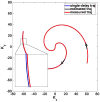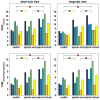Non-Cartesian balanced steady-state free precession pulse sequences for real-time cardiac MRI
- PMID: 25960254
- PMCID: PMC4637255
- DOI: 10.1002/mrm.25738
Non-Cartesian balanced steady-state free precession pulse sequences for real-time cardiac MRI
Abstract
Purpose: To develop a new spiral-in/out balanced steady-state free precession (bSSFP) pulse sequence for real-time cardiac MRI and compare it with radial and spiral-out techniques.
Methods: Non-Cartesian sampling strategies are efficient and robust to motion and thus have important advantages for real-time bSSFP cine imaging. This study describes a new symmetric spiral-in/out sequence with intrinsic gradient moment compensation and SSFP refocusing at TE = TR/2. In vivo real-time cardiac imaging studies were performed to compare radial, spiral-out, and spiral-in/out bSSFP pulse sequences. Furthermore, phase-based fat/water separation taking advantage of the refocusing mechanism of the spiral-in/out bSSFP sequence was also studied.
Results: The image quality of the spiral-out and spiral-in/out bSSFP sequences was improved with off-resonance and k-space trajectory correction. The spiral-in/out bSSFP sequence had the highest signal-to-noise ratio (SNR), contrast-to-noise ratio, and image quality ratings, with spiral-out bSSFP sequence second in each category and the radial bSSFP sequence third. The spiral-in/out bSSFP sequence provides separated fat and water images with no additional scan time.
Conclusions: In this study, a new spiral-in/out bSSFP sequence was developed and tested. The superiority of spiral bSSFP sequences over the radial bSSFP sequence in terms of SNR and reduced artifacts was demonstrated in real-time MRI of cardiac function without image acceleration.
Keywords: bSSFP; fat-water separation; real-time cardiac imaging; spiral; spiral-in/out.
© 2015 Wiley Periodicals, Inc.
Figures









Similar articles
-
Efficient spiral in-out and EPI balanced steady-state free precession cine imaging using a high-performance 0.55T MRI.Magn Reson Med. 2020 Nov;84(5):2364-2375. doi: 10.1002/mrm.28278. Epub 2020 Apr 14. Magn Reson Med. 2020. PMID: 32291845 Free PMC article.
-
Free-breathing cine imaging with motion-corrected reconstruction at 3T using SPiral Acquisition with Respiratory correction and Cardiac Self-gating (SPARCS).Magn Reson Med. 2019 Aug;82(2):706-720. doi: 10.1002/mrm.27763. Epub 2019 Apr 21. Magn Reson Med. 2019. PMID: 31006916 Free PMC article.
-
Improved dark blood imaging of the heart using radial balanced steady-state free precession.J Cardiovasc Magn Reson. 2016 Oct 19;18(1):69. doi: 10.1186/s12968-016-0293-7. J Cardiovasc Magn Reson. 2016. PMID: 27756330 Free PMC article.
-
Practical applications of balanced steady-state free-precession (bSSFP) imaging in the abdomen and pelvis.J Magn Reson Imaging. 2017 Jan;45(1):11-20. doi: 10.1002/jmri.25336. Epub 2016 Jul 4. J Magn Reson Imaging. 2017. PMID: 27373694 Review.
-
Clinical Applications of Cine Balanced Steady-State Free Precession MRI for the Evaluation of the Subarachnoid Spaces.Clin Neuroradiol. 2015 Dec;25(4):349-60. doi: 10.1007/s00062-015-0383-1. Epub 2015 Apr 9. Clin Neuroradiol. 2015. PMID: 25854921 Review.
Cited by
-
SPRING-RIO TSE: 2D T2 -Weighted Turbo Spin-Echo brain imaging using SPiral RINGs with retraced in/out trajectories.Magn Reson Med. 2022 Aug;88(2):601-616. doi: 10.1002/mrm.29210. Epub 2022 Apr 8. Magn Reson Med. 2022. PMID: 35394088 Free PMC article.
-
Non-Cartesian slice-GRAPPA and slice-SPIRiT reconstruction methods for multiband spiral cardiac MRI.Magn Reson Med. 2020 Apr;83(4):1235-1249. doi: 10.1002/mrm.28002. Epub 2019 Sep 30. Magn Reson Med. 2020. PMID: 31565819 Free PMC article.
-
Recent Advances in Cardiovascular Magnetic Resonance: Techniques and Applications.Circ Cardiovasc Imaging. 2017 Jun;10(6):e003951. doi: 10.1161/CIRCIMAGING.116.003951. Circ Cardiovasc Imaging. 2017. PMID: 28611116 Free PMC article. Review.
-
A cardiovascular magnetic resonance (CMR) safe metal braided catheter design for interventional CMR at 1.5 T: freedom from radiofrequency induced heating and preserved mechanical performance.J Cardiovasc Magn Reson. 2019 Mar 7;21(1):16. doi: 10.1186/s12968-019-0526-7. J Cardiovasc Magn Reson. 2019. PMID: 30841903 Free PMC article.
-
Content-aware compressive magnetic resonance image reconstruction.Magn Reson Imaging. 2018 Oct;52:118-130. doi: 10.1016/j.mri.2018.06.008. Epub 2018 Jun 20. Magn Reson Imaging. 2018. PMID: 29935257 Free PMC article.
References
-
- Carr HY. Steady-State Free Precession in Nuclear Magnetic Resonance. Physical Review. 1958;112(5):1693.
-
- Oppelt A, Graumann R, Barfuss H, Fischer H, Hartl W, Sharjor W. FISP--a new fast MRI sequence. Electromedica. 1986;54:15–18.
-
- Scheffler K, Lehnhardt S. Principles and applications of balanced SSFP techniques. Eur Radiol. 2003;13(11):2409–2418. - PubMed
-
- Bauer RW, Radtke I, Block KT, Larson MC, Kerl JM, Hammerstingl R, Graf TG, Vogl TJ, Zhang S. The International Journal of Cardiovascular Imaging. 2013;29(5):1059–1067. - PubMed
-
- Meyer CH, Hu BS, Nishimura DG, Macovski A. Fast spiral coronary artery imaging. Magn Reson Med. 1992;28(2):202–213. - PubMed
Publication types
MeSH terms
Grants and funding
LinkOut - more resources
Full Text Sources
Other Literature Sources
Research Materials

